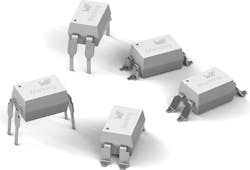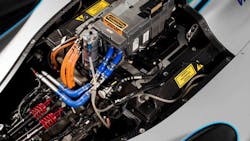>> Electronic Design Resources
.. >> Library: Article Series
.. .. >> Article Series: PowerBites
In Case You Missed It: Could Lordstown Motors' Electric Pickup Out-Muscle Tesla's Cybertruck?
Between the pandemic, and all the other happenings in the Technosphere, it would have been easy to miss Lordstown Motors' rollout of its Endurance electric pickup truck earlier this month (see the video below). After reviving an abandoned GM plant in America's heartland, the upstart company is preparing to put the Endurance into production in January 2021—several months or more ahead of the "late 2021" date anticipated for Tesla's Cybertruck.
More than being competition for Tesla, its arrival may be confirmation that electric trucks are poised to take a substantial chunk of the sales currently enjoyed by their fossil-burning brethren. While not anywhere a sure thing, a number of signs point to the endurance perhaps being another accelerant in the electric-truck revolution started by Tesla.
Unlike the Tesla's wedgy, unconventional, and scary-tough appearance, Endurance's designers worked overtime to give it the reassuring lines of the workhorses that are beloved by generations of contractors, farmers, and other folks who do the hard, dirty work that keeps our nation alive. So, while Tesla's Cybertruck may have opened the debate on whether America is ready to embrace electric pickup trucks, the Endurance may help close the case by offering more familiar looking steed that's just as rugged, quite likely more reliable, and clearly less expensive to operate.
But underneath the mom-and-apple-pie appearance lurks a series of technical features and design choices that nearly equal the sheer audacity of Tesla's work vehicle. Sporting four in-wheel hub motors, the Endurance promises to reduce the cost, weight, and energy losses associated with conventional drivetrains. And, although it's only speculation at this point, the presence of the battery plant—a joint venture between GM and LG Chem—in Lordstown is a strong indicator that the truck may benefit from the unique modular battery technology that will be made there to support the electrification of GM's fleet.
There are also some valid concerns about how well a new company can bring such a complex and unconventional vehicle to market. At least some of those worries can be put to rest when you consider that a large percentage of the Lordstown facility's engineering and manufacturing team consists of seasoned GM employees, and that the management team has a decidedly un-GM-esque approach to the automobile business. But, regardless of whether it succeeds or not, it's a good bet that Lordstown Motors will help drive the electrification of trucks elsewhere around the world.
Stay tuned to PowerBites for further developments...
GaN-Based 12-V Class-D Audio Amplifier Ref Designs Offer Amazing Sound for Cars, Boats, Powersports
As part of its campaign to bring the power of gallium nitride (GaN) to automotive, marine, powersports, and other portable audio products, GaN Systems released a series of reference designs along with a technical manual titled, “12V High-Efficiency Audio Reference Designs using GaN Power Transistors.” This initiative follows the well-received launch of its 200-W Class-D audio amplifier evaluation kit, which is primarily intended for home and commercial audio products.
The manual details several amplifier designs intended for operation on 12-V supplies that are based on GaN Systems’ Class-D audio amplifier evaluation kit. The kit includes a two-channel, 200-W-per-channel (8 Ω) Class-D audio amplifier and a companion 400-W, continuous-power audio-grade SMPS, including:
- Single-phase and dual-phase 12-V boost converter design that supports both a “direct” +12- to +18-V single-rail power supply, and a “boosted” +12- to +18-V single-rail power-supply configuration.
- Direct +12- to +18-V VIN supply to ±32-V VOUT boost converter design that supports a “direct” +12- to +18-V VIN supply and allows for the best cost versus power output tradeoff, while maintaining the desired audio performance.
The technical manual and reference designs for 12-V applications is available for download by clicking here. A white paper, titled “See, Feel, and Hear the Difference with GaN Class-D Amplifier and Companion SMPS,” is available by clicking here.
Robust Optocouplers Provide Clean Signal Transmission and Reliable Galvanic Isolation
Würth Elektronik's WL-OCPT Series 816 family of coplanar design optocouplers are designed to provide highly isolated control and communication paths for power supplies and chargers, computers and microprocessors, electricity meters and many other applications that require signal transmission and safe galvanic isolation. The devices consist of an infrared LED on the input side and a phototransistor on the output side. They’re characterized by a high insulation voltage of 5 kV and a stable current transfer ratio (CTR) over the entire operating temperature range.
The WL-OCPT comes in five different THT and SMT contacting variants, each with five CTR binnings from 50% to 600%. To ensure the highest reliability and performance, the optocouplers are constructed on a copper lead frame instead of the more commonly used iron lead frames. The coplanar structure inside the white housing keeps a fixed distance gap to ensure overvoltage protection. The operating temperature range of the WL-OCPT is −55 to +110°C and the CTR is stable over this entire range. The maximum collector-emitter voltage for this series is 80 V.
The WL-OCPT 816 series is certified according to VDE EN60747-5-5:2011 (No. 40051484), UL 1577 (No. E513104) and CQC GB4943.1-2001; GB8898-2011 (No. CQC20001244742). Free samples of the optocouplers with phototransistor output are available now. All 25 products in the 816 series are available from stock without a minimum order quantity. To learn more, visit the product home page.
Highly Integrated Flyback Switcher IC Targets Automotive BEV and PHEV Applications
Power Integrations announced the production release of its InnoSwitch 3-AQ, an AEC-Q100-qualified flyback switcher with integrated 750-V MOSFET and secondary-side sensing. The newly qualified device family targets automotive electric-vehicle (EV) applications, such as traction inverters, OBCs (on-board chargers), EMS (energy-management dc-dc bus converters), and BMS (battery management systems).
The InnoSwitch3-AQ uses the company’s high-speed FluxLink coupling to achieve ±3% accuracy for combined line and load regulation while eliminating both dedicated isolated transformer sense-windings and optocouplers. FluxLink technology maintains output-voltage regulation even under the transient stress test, which is particularly challenging for PSR-based implementations.
The integrated 750-V MOSFET meets stringent automotive derating requirements, and an on-chip synchronous rectifier controller delivers over 90% efficiency at the nominal 400-V dc input voltage. Designs based on the InnoSwitch3-AQ can achieve less than 10 mW no-load energy usage across the input voltage range.
InnoSwitch3-AQ ICs come in a surface-mount InSOP-24D package with 11-mm primary to secondary creepage, which exceeds the stringent requirements for high altitude (> 5000 m) isolation. Devices are available now with prices starting at $2.75 in 10,000-piece quantities. Designers can evaluate the new devices using the RDR-840Q reference design kit, which demonstrates startup, shutdown, and efficient operation from 30- to 550-V dc input, as well as fast transient response and a variety of safety and protection features.
Technical support for the chipset is available from the Power Integrations website at: https://ac-dc.power.com/products/innoswitch3-aq.
Partnership Aims to Bring GaN-Based Power Electronics to the Road, Track, and Skies
GaN Systems and BrightLoop Converters announced their strategic partnership to develop the latest ac-dc and dc-dc converter products for electric motorsport and aerospace applications. BrightLoop produces a range of converters for powering electric vehicles' low-voltage subsystems directly off of their primary high-voltage supply. The company says that by leveraging GaN Systems’ 650-V GaN transistors, its converters are smaller, lighter, and more efficient than any others currently available in the market.
BrightLoop’s most recent family of dc-dc converters, including 1.9-, 4.8-, and 9.6-kW options, is designed for hybrid and electric racing and incorporates GaN Systems transistors. The resulting products are roughly half the size and weight of the company’s first-generation dc-dc converter, which was based on conventional silicon power devices.
Many Formula E teams use BrightLoop’s dc-dc converters, including the winning team from 2019. The converter’s function is to power all of the low-voltage electronics, including pumps, lighting, and radio. Most recently, the World Sporting Consulting (WSC) Group, the premier motorsport event and racing promotion organization overseeing TCR (Touring Car Racing) and ETCR (Electric Touring Car Racing) brands, announced BrightLoop as the sole supplier of dc-dc converters for ETCR cars. ETCR is the world’s first electric touring car championship, which will begin this summer 2020.
In addition, BrightLoop will unveil a high performance 5-kW ac-dc power-factor-correction (PFC) product for aerospace applications coming later next year, which also incorporates GaN Systems transistors. It operates from an input voltage of 60 to 180 V ac and achieves 96% efficiency.
For more information about GaN Systems and BrightLoop’s collaboration, download the case study by clicking here.
>> Electronic Design Resources
.. >> Library: Article Series
.. .. >> Article Series: PowerBites






